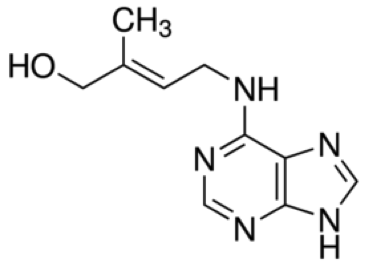
Zeatin is a plant hormone derived from adenine, which is a nucleobase. The chemical molecular formula of Zeatin is C10H13N5O. Zeatin belongs to the family of plant-growth hormones called cytokinins, which are a class of plant growth substances , also known as phytohormones with the function to promote cell division, or cytokinesis, in plant roots and shoots. The name of Zeatin comes from the genus Zea and Zeatin was discovered in the immature corn kernels from the genus Zea for the first time.
Scientists at Creative Proteomics utilize a highly quantitative method with high-performance liquid chromatography (HPLC) for the determination of Zeatin levels in various samples, including Plant, Tissue and more. High-Performance Liquid Chromatography (HPLC) with UV detection is used for the determination of Zeatin (254 nm) levels in a lot of biological samples. This Methodology provides accurate, reliable, and reproducible results of Zeatin measurement, which enables us to analyze of Zeatin levels in vitro and in vivo.
Zeatin has various applications in the field of agriculture. For example, Zeatin in combination with auxin can promote callus initiation at the concentration is 1 ppm. With the concentration of 100 ppm Zeatin plus 500 ppm GA3 and 20 ppm NAA can promote the fruit set when sprayed at 10th, 25th, 40th day after blossom. Zeatin is also used to retards yellowing for vegetables at the concentration is 20 ppm. There are also some research results shows that Zeatin can cause auxiliary stems to grow and flower. Zeatin can also be used to promote seed germination and seedling growth. In addition of these applications in the field of agriculture, Zeatin has several anti-aging effects on human skin fibroblasts.
The Russian-Polish botanist M. Tswett is generally recognized as the first person to establish the principles of chromatography. In a paper he presented in 1906, Tswett described how he filled a glass tube with chalk powder (CaCO3) and, by allowing an ether solution of chlorophyll to flow through the chalk, separated the chlorophyll into layers of different colors. He called this technique “chromatography”. Fundamentally, chromatography is a technique used to separate the components contained in a sample. High Performance Liquid Chromatography (HPLC) is a method able to separate non-volatile, thermally unstable, and polar components separate or in a mixture. HPLC is a type of chromatography that, because of its wide application range and quantitative accuracy, is regarded as an indispensable analytical technique, particularly in the field of organic chemistry. It is also widely used as a preparation technique for the isolation and purification of target components contained in mixtures.
Zeatin Analysis Service Analysis Service at Creative Proteomics supports your research in Zeatin Analysis. HPLC Based Analysis Service Platform enable us at Creative Proteomics offers you a state-of-the-art Analysis Service.
Sample Type
Plant, Tissue and more
Method
High-Performance Liquid Chromatography (HPLC) with UV detection is used for the determination of Zeatin (254 nm) levels in a lot of biological samples. This Methodology provides accurate, reliable, and reproducible results of Zeatin measurement, which enables us to analyze of Zeatin levels in vitro and in vivo.
Send us your samples, you will get all information that you need!







